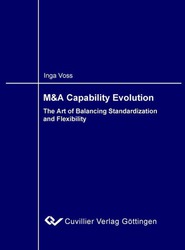| Departments | |
|---|---|
| Book Series (96) |
1378
|
| Nachhaltigkeit |
3
|
| Gesundheitswesen |
1
|
| Humanities |
2363
|
| Medienwissenschaften | 16 |
| Theology | 57 |
| Philosophy | 102 |
| Law | 422 |
| Economics | 850 |
| Social sciences | 416 |
| Sports science | 48 |
| Psychology | 233 |
| Educational science | 190 |
| History | 182 |
| Art | 110 |
| Cultural studies | 166 |
| Literary studies | 116 |
| Linguistics | 88 |
| Natural Sciences |
5406
|
| Engineering |
1791
|
| Common |
97
|
|
Leitlinien Unfallchirurgie
5. Auflage bestellen |
|
Advanced Search
M&A Capability Evolution (English shop)
The Art of Balancing Standardization and Flexibility
Inga Voss (Author)Preview
Table of Contents, Datei (32 KB)
Extract, Datei (70 KB)
Acquisitions are a highly risky venture and often result in failure. Recent theoretical and practical evidence, however, indicates that in the course of the current sixth merger wave some frequent acquirers have developed a specific M&A; capability. This capability enables them to outperform other, less capable frequent acquirers, as well as single acquirers. This phenomenon is largely unexplored.
Inga Voss presents a mid-range theory of M&A; capability evolution based on an in-depth analysis in four of a large corporation’s business groups. She develops an empirically grounded model of M&A; capability evolution and finds that different M&A; capability types evolve in the course of firms’ acquisition strategies. On this basis, she develops a contingency model of M&A; capability evolution. The author further identifies two managerial engineering activities contributing to the evolution of successful M&A; capability. Lastly, she integrates the insights into a central frame (middle-up-down management) with which to achieve a balance between standardization and flexibility. Such a balance is regarded as vitally important for successful M&A; capability evolution.
This study thus contributes to both theory and practice. In respect of theory, it contributes by shedding light on the insufficiently explored topics ‘management of acquisition strategies’, ‘learning from M&A;’, and ‘dynamic capability evolution.’ It links research on learning and capability evolution, thereby contributing to the repeatedly postulated convergence of different theoretical streams to gain interesting new insights in the strategy process field. In respect of practice, it contributes by providing managers with normative guidance regarding how to engineer the evolution of the M&A; capability type that suits their specific contextual challenges.
This book is recommended for academics and students in the field of strategic management who are interested in M&A; and dynamic capabilities research. It also addresses practitioners who are searching for better ways to approach their M&A; management in accordance with their specific contextual challenges
| ISBN-13 (Printausgabe) | 3867274568 |
| ISBN-13 (Hard Copy) | 9783867274562 |
| ISBN-13 (eBook) | 9783736924567 |
| Final Book Format | A5 |
| Language | English |
| Page Number | 320 |
| Edition | 1 |
| Volume | 0 |
| Publication Place | Göttingen |
| Place of Dissertation | St. Gallen |
| Publication Date | 2007-12-10 |
| General Categorization | Dissertation |
| Departments |
Economics
|








